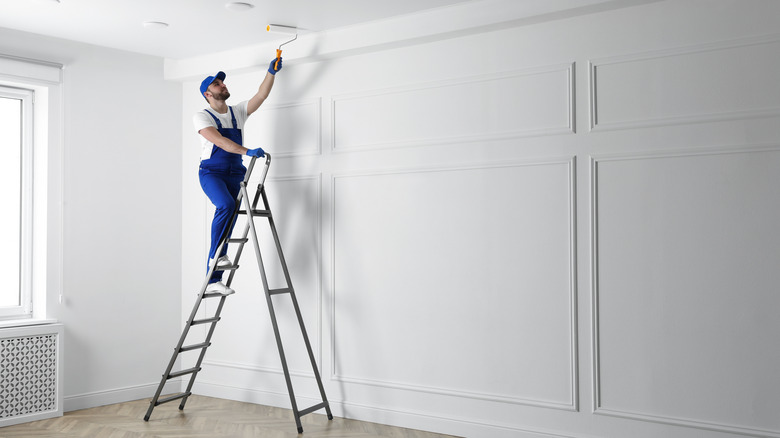Here's How To Pick The Best Shade Of White To Paint Your Ceiling
When you're painting your home, it can be tempting to simply give everything a coat of the same paint — trim, and ceiling included. But, it turns out, that might not always be the best bet, especially if you're working with a darker color. It's a myth that darker colors make rooms feel smaller, but these hues can feel more overwhelming and heavy because they don't reflect as much light. This is great for rooms where you want that weighty coziness, like a library or bedroom, but other spaces work best with a bit more balance and contrast between hues to lighten things up.
That's where the white ceiling comes in. White is a true neutral shade that works with just about any color you could choose for your space. Incorporating a bit into your ceiling can bring some much-needed contrast and break up an otherwise oppressive coat of your chosen swatch. To pull this off without everything looking disjointed, however, it's important to choose the correct shade of white before you start painting your ceilings.
Take a look at your main color's undertones
All colors can be sorted into one of three categories: warm, cool, and neutral. While it might seem like it doesn't make much of a difference when you're simply choosing a white paint, sticking to the same color family as your main paint color can help everything look cohesive and flow more naturally, even if there is a large amount of contrast between the depth of the shades.
Say, for example, you're painting your bathroom a light, refreshing blue. Choosing a cool-toned white for the ceiling is your best bet, as these two shades fit together. If you were to choose a warm-toned white, it might come off looking yellowed or dirty. However, in a warmer-toned room, this shade of white would appear completely harmonious.
For even more precision, you can also look for an ultra-pastel version of the color you're using to paint, essentially a white with undertones of your specific color. If you're having trouble differentiating in the paint aisle, consider checking out the paint brand's website. They will likely list more specific descriptions of the color online.
Stick to a true neutral white
In some situations, you don't have the time or energy to find the perfect complementary white paint for every room in your home. In that case, it's best to find something that's a true neutral. It might not flow as seamlessly as a shade in the matching family, but it shouldn't cause any issues either, similar to the flexibility of colors like greige. There's also the added benefit of being able to use it in multiple rooms, even if you decide to paint them a different color down the line. The problem? True neutrals are often hard to track down.
Some of the most popular options include Behr's Blanca Peak and Benjamin Moore's Chantilly Lace. If you're having a difficult time finding a true neutral, however, don't be afraid to ask the salesperson at your hardware store for help. Staring at paint samples for hours, especially when everything is so similar, can seemingly drive you to the brink of insanity. The people who mix the paint can see exactly how much of each color pigment goes into the can, giving you a more precise, mathematical approach to a neutral than your eyes can provide.


